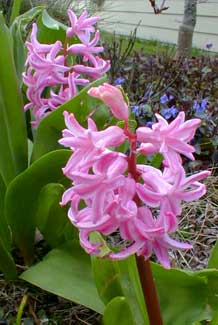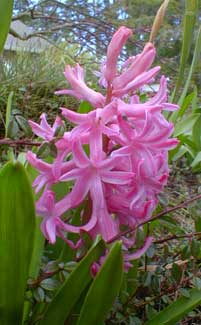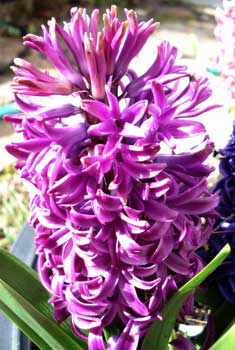
'Pink Pearl'
Hyacinth
"Or they might watch the quoit-pitchers, intent
On either side; pitying the sad death
Of Hyacinthus, when the cruel breath
Of Zephyr slew him -- Zephyr penitent,
Who now, ere Phoebus mounts the firmament,
Fondles the flower amid the sobbing rain."
-John Keats
(1795-1821)
(1795-1821)
 Opening between mid & late March, 'Pink Pearl' oriental hyacinth is sometimes a week later than other colors in garden, hence still around through early April when those which bloomed early March have faded.
Opening between mid & late March, 'Pink Pearl' oriental hyacinth is sometimes a week later than other colors in garden, hence still around through early April when those which bloomed early March have faded.The rose-pink florets are paler pink along the edges, giving 'Pink Pearl' its pearly sheen. It blooms before the maples have re-leafed, so they have the sun required while blooming underneath a cherry tree or a Japanese maple.
In the garden their fragrance can be detected from a considerable distance. A single bloom brought into the house is large enough to make an impact all by itself, & sufficiently redolent to fill a large room with perfume. Because of the weight of the flowers, they do sometimes "lodge" or tip over in the garden; most don't, because they're short with thick stalks;
but when does do so, that's the one to cut & bring indoors.
'Pink Pearl' was bred by the Dutch grower J.W.A. Lefeber & released in 1922. Although tulips get all the fame, cultivation of Oriental hyacinths goes back four hundred years in Holland, which is recent garden history for these garden treasures, since the ancient Greeks & Romans had already brought bulbs to Europe from Turkey.
The ancients told the tale of how hyacinths sprang from the blood of Hyacinthos, the young athlete whom Apollo loved but accidentally killed when the jealous wind-god Zephyr blew upon either a quoit or a discus which Apollo had thrown.
 Growing hyacinths is the easiest thing, so it is suprising that their breeding & propogation is much more complicated than for most early spring bulbs & not likely to be undertaken by anyone but specialized professionals. For all practical purposes a gardener only has as many hyacinths as bulbs that were purchased. Wherever you plant one bulb it will perennialize but not naturalize, & there will always be just one bulb in that spot. This means at least that they never have to be lifted for separation.
Growing hyacinths is the easiest thing, so it is suprising that their breeding & propogation is much more complicated than for most early spring bulbs & not likely to be undertaken by anyone but specialized professionals. For all practical purposes a gardener only has as many hyacinths as bulbs that were purchased. Wherever you plant one bulb it will perennialize but not naturalize, & there will always be just one bulb in that spot. This means at least that they never have to be lifted for separation.They bloom fabulously in sun or bright shade. If treated as annuals they can be grown in deep shade, but will not be able to recharge sufficiently to perform well the second year. In a sunnier location they will return each spring pretty much indefinitely.
When purchasing bulbs it is tempting to spend the extra money for super-large ones. These produce enormous flower heads with sixty or seventy florets on each bulb's single stem. For indoor forcing this may be fine, but in the open garden this enormous bloom will be way too top-heavy & lodging becomes a much more likely disappointment. Mid-sized hyacinth bulbs produce smaller blooms but still pretty darned big, with far fewer tip-overs. When cataloged, the bulb size will be listed, & those which are listed as 15/16 or 16/17 are best. Anything larger should be reserved for indoor forcing.
Hyacinths happily aren't much liked by deer because they are toxic, & for the same reason rodents do not dig up the bulbs. The bulbs can cause contact dermatitis & it is usually recommended that anyone with sensitive skin handle them only with gloves.